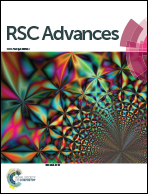Polymer-grafted superparamagnetic iron oxide nanoparticles as a potential stable system for magnetic resonance imaging and doxorubicin delivery†
Abstract
Currently, there is high interest in developing multifunctional theranostic platforms with both imaging and therapeutic functions. Herein, we report a facile approach to develop polymer-grafted superparamagnetic iron oxide nanoparticles (SPIONs) as a promising system for imaging and drug delivery. A random copolymer composed of pendant-activated ester moieties, that is, pentafluorophenyl acrylate (PFPA) and polyethylene glycol monomethyl ether methacrylate (PEGMA), were synthesized and grafted on SPION surfaces using the click reaction. The resultant multifunctional SPIONs were characterized using FT-IR, XRD, XPS, TGA and TEM, proving the presence of polymers on their surfaces. The formed polymer-grafted SPIONs are water-dispersible, stable, and biocompatible as confirmed by a cell viability assay. Relaxivity measurements show that they have a  relaxivity (
relaxivity ( ) of 134.40 mM−1 S−1, which is higher than the value obtained from the commercial FDA approved MRI contrast agent Ferumoxytol (85 mM−1 S−1). Furthermore, doxorubicin (DOX) was loaded onto the polymeric shell of modified SPIONs and exhibited fast drug release in response to acidic conditions (pH 5.4). These results clearly indicate that the prepared modified SPIONs have great potential to serve as a multifunctional nanosystem for T2-weighted MR imaging and therapy.
) of 134.40 mM−1 S−1, which is higher than the value obtained from the commercial FDA approved MRI contrast agent Ferumoxytol (85 mM−1 S−1). Furthermore, doxorubicin (DOX) was loaded onto the polymeric shell of modified SPIONs and exhibited fast drug release in response to acidic conditions (pH 5.4). These results clearly indicate that the prepared modified SPIONs have great potential to serve as a multifunctional nanosystem for T2-weighted MR imaging and therapy.


 Please wait while we load your content...
Please wait while we load your content...